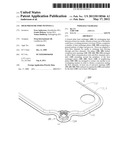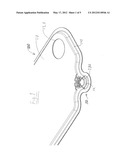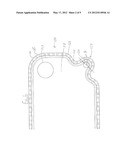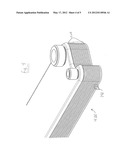Patent application title: HIGH PRESSURE PORT PENINSULA
Inventors:
Sven Andersson (Hassleholm, SE)
Svante Hoberg (Astorp, SE)
Tomas Dahlberg (Helsingborg, SE)
Tomas Dahlberg (Helsingborg, SE)
Assignees:
SWEP International AB
IPC8 Class: AF28D900FI
USPC Class:
165170
Class name: Heat exchange conduit within, or conforming to, panel or wall structure opposed plates or shells
Publication date: 2012-05-17
Patent application number: 20120118546
Abstract:
A brazed plate heal exchanger (400) for exchanging heat between at least
two media, wherein at least one of the media could have a working
pressure of at least 50 bars, comprises a number of heat exchanger plates
(100; 200) comprising a pressed pattern of ridges and grooves. Those are
adapted to form flow channels for media to exchange heat flowing through
said flow channels. The plates (100; 200) further comprises port openings
(120, 130; 220; 300, 310) arranged to allow fluid communication with said
flow channels and a skirt (140) extending around the periphery of the
heat exchanger plates (100; 200). Skirts (140) of neighboring plates
(100; 200) are arranged to contact one another in an overlapping manner
in order to obtain a connection sealing the flow channels. At least one
of said port openings (120, 130; 220; 300, 310) is placed on a peninsula
(150) surrounded by the skirt (140) over at least 100 degrees.Claims:
1. A brazed plate heat exchanger for exchanging heat between at least two
media, wherein at least one of the media could have a working pressure of
at least 50 bars, the heat exchanger comprising a number of heat
exchanger plates comprising a pressed pattern of ridges and grooves
adapted to form flow channels for media to exchange heat flowing through
said flow channels, the plates further comprising port openings arranged
to allow fluid communication with said flow channels and a skirt
extending around the periphery of the heat exchanger plates, skirts of
neighboring plates being arranged to contact one another in an
overlapping manner in order to obtain a connection sealing the flow
channels, wherein at least one of said port openings is placed on a
peninsula surrounded by the skirt over at least 100 degrees.
2. The brazed plate heat exchanger of claim 1, wherein the skirt surrounds the at least one port opening provided on the peninsula over at least 120 degrees.
Description:
FIELD OF THE INVENTION
[0001] The present invention relates to a heat exchanger comprising a number of heat exchanger plates comprising a pressed pattern of ridges and grooves adapted to form flow channels for media to exchange heat flowing through said flow channels, the plates further comprising at least four port openings arranged to allow fluid communication to said flow channels and a skirt extending around the periphery of the heat exchanger plates, said skirt sealing the flow channels.
PRIOR ART
[0002] In the art of heat pumps, there has been a recent trend to use carbon dioxide as the refrigerant, since carbon dioxide is known to give excellent COP values, i.e. efficiency, in high temperature applications. Moreover, carbon dioxide has very little impact on the environment, compared to the refrigerants that are commonly used today.
[0003] One problem with using carbon dioxide is that its operating pressure is high; other commonly used coolants operate at pressures of up to 40 bars, but carbon dioxide systems must be able to withstand pressure of about 140 bars. This high pressure makes it necessary to use heat exchangers able to withstand such pressures. A relatively common type of heat exchanger for carbon dioxide applications is the "dual pipe" exchanger, which comprises two parallel pipes, which are interconnected to enable heat transfer between the pipes. Usually, a pipe with a small diameter is used for the high pressure medium, whereas a pipe with a large diameter is used for the low pressure medium. In order to increase the heat exchanging area, more than one small diameter pipe may be interconnected to a pipe having a larger diameter, and there are even designs wherein the small diameter pipes are embedded within a pipe wall of the large diameter pipe. Dual pipe heat exchangers have excellent properties concerning capability to withstand pressure, but are inefficient in terms of heat exchanging capability vs. weight.
[0004] For ordinary heat pump applications, i.e. applications wherein a commonly used coolant is used, one common type of heat exchanger is a Compact Brazed Exchanger (CBE). This type of heat exchanger is efficient both in terms of cost, performance, material requirement and space requirement, but CBE:s have up till now exhibited a low capability of withstanding high pressure, i.e pressures exceeding about 50 bars.
[0005] A CBE generally comprises a number of heat exchanger plates, all of which being provided with a pressed pattern of ridges and grooves and port openings for fluid communication with flow channels formed by interaction between the pressed patterns of ridges and grooves of neighboring plates. The pressed patterns of neighboring plates are arranged such that ridges of one plate contact grooves of a neighboring plate. During the brazing operation, the contact points are brazed to one another to provide sufficient strength to the flow channel formed by the patterns of ridges and grooves of neighboring plates. The flow channels formed by the interaction between the ridges and grooves are laterally sealed by interacting skirts provided around the circumference of the heat exchanger plates.
[0006] Pressure tests of CBE:s have shown that one position where the heat exchangers are particularly prone to break is the port openings, or rather, the heat exchanging area between the port openings. The reason for this is rather clear; the contact point density is low in the vicinity of the port openings, due to the surface area of the port openings, which surface area is free of joined contact points between the plates. Despite the lower contact point density, the same force for an equal pressure must be transferred through the contact points.
[0007] It is the object of the invention to provide a CBE able to withstand a pressure high enough for allowing the heat exchanger to be used in carbon dioxide applications.
SUMMARY OF THE INVENTION
[0008] According to the invention, this and other problems are solved by providing at least one of the port openings on a peninsula which extends outside the general area of a heat exchanging surface of heat exchanger plates comprised in the heat exchanger, said peninsula being closely surrounded by skirts over at least 100 degrees.
BRIEF DESCRIPTION OF THE DRAWINGS
[0009] Hereinafter, the invention will be described with reference to the appended drawings, wherein:
[0010] FIG. 1 is a perspective view of a heat exchanger plate according to a first embodiment of the present invention;
[0011] FIG. 2 is a plan view of a heat exchanger plate according to a second embodiment of the present invention;
[0012] FIG. 3 is a perspective view of a heat exchanger plate according to a third embodiment of the present invention;
[0013] FIG. 4 is a perspective view of a heat exchanger manufactured from a number of heat exchanger plates according to the third embodiment; and
[0014] FIG. 5 is a perspective view of a heat exchanger plate according to a fourth embodiment of the present invention.
DESCRIPTION OF EMBODIMENTS
[0015] With reference to FIG. 1, a heat exchanger plate 100 comprises a heat exchanging area 110, provided with a pressed pattern (not shown) of ridges and grooves, in a way well known to persons skilled in the art. The patterns of ridges and grooves of neighboring plates are adapted to provide flow channels between the plates due to contact between ridges of one plate contacting grooves of its neighboring plate when the plates 100 are stacked onto one another in a way well known by persons skilled in the art. The heat exchanger 100 also comprises at least two low pressure port openings 120 and two high pressure openings 130. The port openings are in selective fluid communication with the flow channels formed by the pattern of ridges and grooves in a way to be described below. A skirt 140 surrounds the heat exchanging area 110 and is arranged such that two skirts of neighboring plates interact to form a seal between such neighboring plates by an overlapping engagement between neighboring skirts, hence sealing the flow channels formed by the pressed pattern of ridges and grooves.
[0016] As can be seen in FIG. 1, the high pressure port 130 is placed on a "peninsula" 150 extending out from the heat exchanging area 110. The peninsula 150 is closely surrounded by the skirt 140 over an angle α of about 180 degrees.
[0017] The angle α is more clearly defined in FIG. 2. FIG. 2 shows virtually the same embodiment as is shown in FIG. 1, with the exception that FIG. 2 shows the skirt 140 being surrounded by a plate portion 160 which is provided with a pressed pattern of ridges and grooves. The ridges and grooves 165, 166, respectively, of the plate portion 160 are adapted to contact corresponding ridges and grooves of the plate portion 160 of a neighboring plate, and hence increase the strength of the seal formed by the skirt 140.
[0018] FIG. 3. shows still a further embodiment of a heat exchanger plate 200 according to the present invention. A peninsula 210 extends in a direction parallel to a length axis of the heat exchanger plate 200, and a high pressure port 220 is located on such peninsula. Please note that the skirt 140 closely surrounds the high pressure port 220 over about 180 degrees.
[0019] In order to manufacture a heat exchanger from a number of heat exchanger plates 100 or 200, a desired number of heat exchanger plates are stacked onto one another. Not all heat exchanger plates 100 or 200 are of the same design, every other plate in the stack is a mirror image of its neighboring plates; by varying the height of the areas surrounding both the high pressure ports and the low pressure ports, it is possible to determine which port opening that shall communicate with each flow channel. This method of determining the fluid communication in a heat exchanger is well known by persons skilled in the art, and will hence not be more thoroughly discussed.
[0020] After the heat exchanger plates have been stacked in the appropriate manner to form a heat exchanger, the entire plate package is subjected to a brazing operation, i.e. the plate package is put into a furnace and heated to a temperature sufficient to melt a brazing material arranged between the plates. After the brazing material has melted, it will concentrate to areas wherein the plates are lying close to one another (the concentration of the brazing material is due to capillary forces). Consequently, the plates will be joined by a brazing connection after the heat exchanger has cooled down sufficiently to allow the brazing material to solidify.
[0021] Whenever an internal pressure is applied to a plate heat exchanger, the plates are forced in opposite directions; hence, the brazing connections between the ridges and grooves of the neighboring plates will be subjected to a tensile stress. Since the skirts 140 are arranged almost perpendicular to the heat exchanging portions of the plates, the force urging the plates in opposite directions will result in a shear stress in the brazing connections between the skirts. However, since the force transmitting area is significantly larger for the overlapping skirts as compared to the contact points between the plates, the skirts will be able to transfer a larger force than the contact points between the plates.
[0022] In FIG. 4, a heat exchanger 400 comprising a number of heat exchanger plates 200 is shown. It can clearly be seen that the skirts 140 form an edge around the circumference of the heat exchanger plates, and it is also very clear how the skirts 140 interact to form a half-pipe like closure around the high pressure port openings 130.
[0023] The half-pipe like closure formed by the skirts 140 around the high pressure port openings 130 gives a very high strength around the port openings; the forces emanating from the surface area of the port will be transferred through the connections between the overlapping skirts.
[0024] In other words, the peninsula placement of the high pressure port 130 increases the strength of the port by fact that a large portion of the port opening lies in the vicinity of the skirt 140; as previously described, skirts 140 of neighboring plates will overlap to form a sealed connection between the plates. Around the high pressure port opening, the overlapping skirts will form a "half-pipe" of overlapping skirts. Such a half pipe-like array of overlapping skirts has proven to be very strong, it can absorb forces in a much more efficient way than e.g. the contact points between the pressed patterns of the heat exchanging areas.
[0025] In another aspect of the present invention, not only the high pressure port is placed on a peninsula; in FIG. 5, a heat exchanger plate according to a further embodiment embodying this feature of the present invention is shown. In this embodiment, both a high pressure port 300 and a low pressure port 310 are placed on peninsulas 320, 330, respectively, the definition of a peninsula being that the skirts surrounding the plates closely surrounds the port openings over more than 90 degrees.
[0026] It should be noted that many modifications are possible within the scope of the invention, such as it has been defined in the appended claims. One such modification is that the skirt 140 not necessarily must be arranged such that it only surrounds the heat exchanger as a whole; it is also possible to provide any portion of the heat exchanger plates with skirts. For example, a skirt could be arranged such that an opening is formed in the heat exchanger; any arrangement wherein plate portions extend in a generally perpendicular direction vis-a-vis a plane of the heat exchanger, and wherein such plate portions of neighboring plates are designed to overlap corresponding plate portions of neighboring plates in a way that has been described above with reference to the skirt 140 are regarded as skirts in the wording of the claims.
User Contributions:
Comment about this patent or add new information about this topic:




